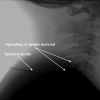The cervical blood patch: A therapeutic "miraculous" for cerebrospinal fluid leaks: A case report
- PMID: 38306558
- PMCID: PMC10843348
- DOI: 10.1097/MD.0000000000037035
The cervical blood patch: A therapeutic "miraculous" for cerebrospinal fluid leaks: A case report
Abstract
Rationale: Cerebrospinal fluid (CSF) leaks, arising from abnormal openings in the protective layers surrounding the spinal cord and brain, are a significant medical concern. These leaks, triggered by various factors including trauma, medical interventions, or spontaneous rupture, lead to the draining of CSF-an essential fluid safeguarding the nervous system. A classic symptom of CSF leaks is an incapacitating headache exacerbated by sitting or standing but relieved by lying down. Spontaneous intracranial hypotension (SIH) denotes the clinical condition marked by postural headaches due to spontaneous CSF leakage and hypotension, often misdiagnosed or underdiagnosed. While orthostatic headaches are the hallmark, SIH may manifest with an array of symptoms including nausea, tinnitus, hearing loss, visual disturbances, and dizziness. Treatment options encompass conservative measures, epidural blood patches (EBP), and surgery, with EBP being the primary intervention.
Patient concern: The patient did not express any specific concerns regarding their medical diagnosis. However, they did harbor apprehensions that their condition might necessitate surgical intervention in the future.
Diagnosis: The patient had been treated with antibiotics with a pre-diagnosis of sinusitis and was admitted to the neurology department of our hospital when his symptoms failed to improve. Cranial magnetic resonance imaging was interpreted as thickening of the dural surfaces and increased contrast uptake, thought to be due to intracranial hypotension. Cranial MR angiography was normal. Full-spine magnetic resonance imaging revealed a micro-spur at the C2 to 3 level and the T1 to 2 level in the posterior part of the corpus.
Interventions: The cervical EBP was performed in the prone position under fluoroscopic guidance. There were no complications.
Outcomes: The patient was invited for follow-up 1 week after the procedure, and control examination was normal.
Lessons: SIH poses a diagnostic challenge due to its diverse clinical presentation and necessitates precise imaging for effective intervention. Cervical EBP emerges as a promising treatment modality, offering relief and improved quality of life for individuals grappling with this condition. However, clinicians must carefully assess patients and discuss potential risks and benefits before opting for cervical blood patches.
Copyright © 2024 the Author(s). Published by Wolters Kluwer Health, Inc.
Conflict of interest statement
The authors have no funding and conflicts of interest to disclose.
Figures
Similar articles
-
Spontaneous C1-2 cerebrospinal fluid leak treated with a targeted cervical epidural blood patch using a cervical epidural Racz catheter.Pain Physician. 2014 May-Jun;17(3):E381-4. Pain Physician. 2014. PMID: 24850128
-
Spontaneous Intracranial Hypotension and Its Management with a Cervical Epidural Blood Patch: A Case Report.Am J Case Rep. 2020 Sep 15;21:e925986. doi: 10.12659/AJCR.925986. Am J Case Rep. 2020. PMID: 32931485 Free PMC article.
-
Thoracic epidural blood patch for spontaneous intracranial hypotension: case report and review of the literature.Turk Neurosurg. 2015;25(2):320-5. doi: 10.5137/1019-5149.JTN.8096-13.1. Turk Neurosurg. 2015. PMID: 26014022 Review.
-
Traumatic vs Spontaneous Cerebrospinal Fluid Hypotension Headache: Our experience in a series of 137 cases.Clin Neurol Neurosurg. 2020 Nov;198:106140. doi: 10.1016/j.clineuro.2020.106140. Epub 2020 Aug 7. Clin Neurol Neurosurg. 2020. PMID: 32791437
-
Spinal Cerebrospinal Fluid Leaks/Intracranial Hypotension.Neurosurg Clin N Am. 2025 Apr;36(2):299-309. doi: 10.1016/j.nec.2024.11.004. Epub 2025 Feb 5. Neurosurg Clin N Am. 2025. PMID: 40054980 Review.
Cited by
-
Targeted Versus NonTargeted Epidural Blood Patch for Spontaneous Intracranial Hypotension: A Systematic Review and Meta-Analysis.Eur J Neurol. 2025 Jun;32(6):e70239. doi: 10.1111/ene.70239. Eur J Neurol. 2025. PMID: 40542558 Free PMC article. Review.
References
-
- Dobrocky T, Nicholson P, Häni L, et al. . Spontaneous intracranial hypotension: searching for the CSF leak. Lancet Neurol. 2022;21:369–80. - PubMed
-
- Farnsworth PJ, Madhavan AA, Verdoorn JT, et al. . Spontaneous intracranial hypotension: updates from diagnosis to treatment. Neuroradiology. 2023;65:233–43. - PubMed
-
- Kranz PG, Gray L, Malinzak MD, et al. . Spontaneous intracranial hypotension: pathogenesis, diagnosis, and treatment. Neuroimaging Clin N Am. 2019;29:581–94. - PubMed
-
- Zetlaoui PJ, Buchheit T, Benhamou D. Epidural blood patch: a narrative review. Anaesth Crit Care Pain Med. 2022;41:101138. - PubMed
Publication types
MeSH terms
LinkOut - more resources
Full Text Sources
Miscellaneous




